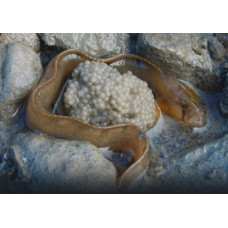Latin name
Pholis gunnellus
Other name
Butterfish
Identification
The body of Rock Gunnel, as well as other members of the genus, is eel-shaped. There are weak teeth on the vomer.
Features of fish fins
The dorsal fin of fishes of this species has a length almost along the entire dorsal spine. The pectoral fins are about 2 times the length of the head. The anal fin is separated from the caudal fin by a notch. The caudal fin is very broad, its width (when spread out) is considerably greater than its length.
Fish colouring
The body of the Rock Gunnel is yellowish-brown with numerous dark transverse stripes that branch out to form a reticulated pattern. Along the base of the dorsal fin is a series of characteristic eye spots - black with a white border (usually 8-15 of them). The fins and underside of the head are yellowish-orange.
Distribution
This fish species is distributed from the Kanin Nose Peninsula in the Barents Sea and further west through the White Sea, Svalbard and Iceland, and south to the west coast of France. It is also found in the North and Baltic Seas. In the waters of the northwestern Atlantic, this species is found off the coast of Labrador and as far south as Delaware.
Habitat
A marine polar demersal species that prefers brackish waters. It inhabits depths down to 35 meters. Its preferred habitat is a rocky bottom covered with algae and seaweed.
Size
The Rock Gunnel has an elongated, ribbon-like body up to 30 cm long. Maximum reported age: 5 years.
Behavior
This species of fish is usually sedentary. Those that are thrown ashore at low tide are able to breathe and wait for the water to come back by hiding under rocks or algae. In winter, they go to greater depths - up to 100 meters and more.
Food and feeding habits
They feed mainly on small crustaceans, molluscs and fish eggs. In their stomachs were found mainly small coastal crustaceans (Amphipoda, Isopoda, Ostracoda, Mysidae, juvenile shrimps, Balanus larvae, etc.), as well as polychaetes, small molluscs, fish eggs, etc. in their stomachs.
Reproduction
These fish spawn during the winter months of November through January. Females lay 80 to 200 eggs between rocks or in empty shells, which are then guarded by males until the fry hatch. Pelagic larvae of 9-10 mm in length appear in February-March off Murman and reach 33-35mm by July, after which they switch to the bottom lifestyle.
Fishing
Rock Gunnel has no management value and is not a fishery.
Relationship with a person
Harmless.
| Classification | |
| Phylum | Chordata |
| Class | Actinopterygii |
| Squad | Perciformes |
| Family | Pholidae |
| Genus | Pholis |
| Species | P. gunnellus |
| Features | |
| Conservation status | Not Evaluated |
| Habitat | No information |
| Life span, years | 5 |
| Maximum body weight, kg | No information |
| Maximum length, cm | 30 |
| Sailing speed, m/s | No information |
| Threat to people | Not edible |
| Way of eating | Planktonophage |
Rock gunnel
Tags: rock gunnel


